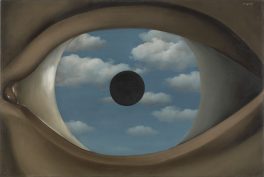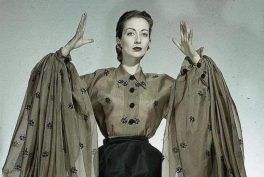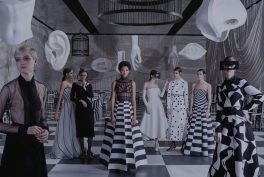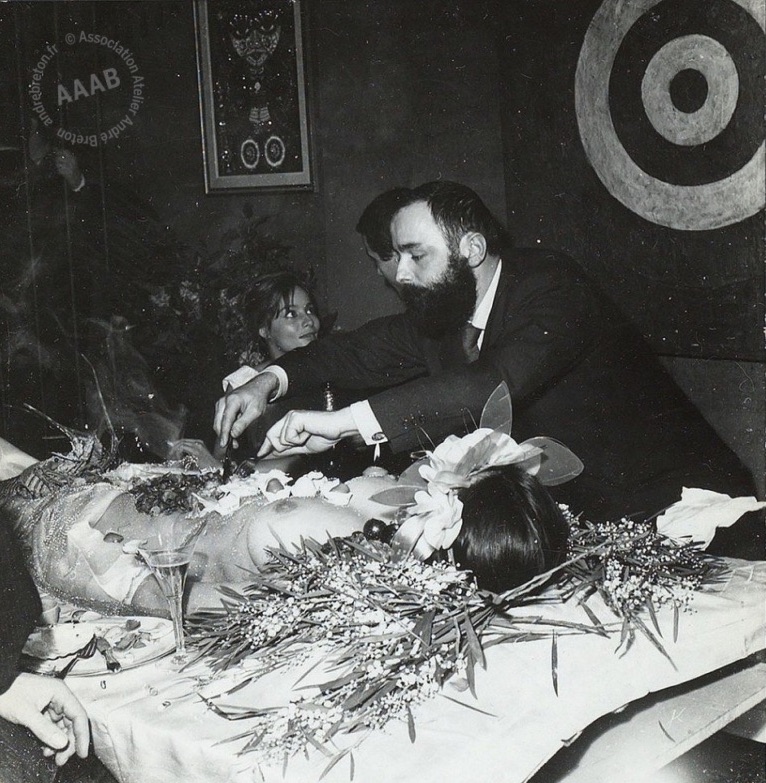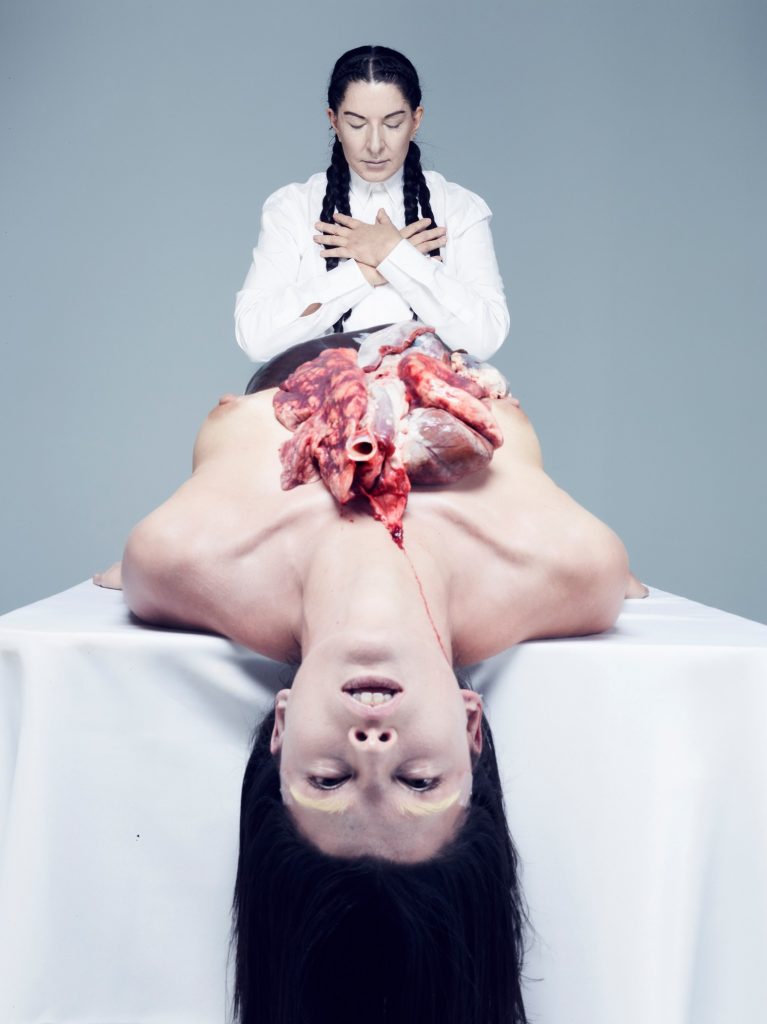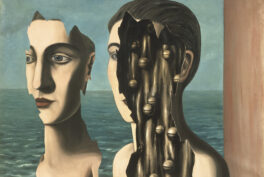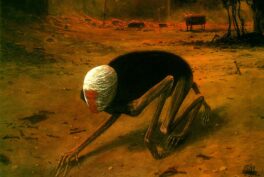Not Just A Surrealist
Before we start, let’s be clear—Meret Oppenheim (1913–1985) was not just a Surrealist—her artistic desires were much broader than that. In her long life, her art encompassed sketching, painting, sculpture, photography, set design, masks, costumes, jewelry (with Elsa Schiaparelli), script writing, and book illustration. Although she is known as the most surreal of all the Surrealists, Meret Oppenheim did not relish the title. Her witty, lively work railed against the restrictions placed upon women and women artists. This trailblazing woman did not like being put in a pigeonhole and turned her back on the Surrealist movement for many years.
1. Object
Our cover image above, this 1936 furry cup-and-saucer set, is perhaps her most famous piece of object art or assemblage, but Meret Oppenheim grew tired of the publicity this work garnered. Surrealists like André Breton were in awe of this object, seizing it as the quintessential motif of their movement. But what’s amusing is that Oppenheim said she soon found the work (also called Luncheon in Fur) boring and felt that its celebrity hindered her freedom of artistic expression.
Domesticity vs. Savagery
Critics and art historians have suggested that the spoon is phallic, the cup is vaginal, while the fur references the pubic zone. Still, others claim it poses genteel, civilized domesticity (the banal cup) against the savage, untamed wild (the animal fur). Later works further explored the civilized vs. wild theme—her fur gloves with wooden fingers, for instance—or her suede gloves embroidered with veins, covering the hand while revealing what pulses within.
The Title
A piece of absurd surrealism, the fur teacup was retitled Luncheon in Fur (Déjeuner en fourrure) by Surrealist artist André Breton for an exhibition he was curating. Breton chose the title with reference to Venus in Furs, an 1870s erotic, sadomasochistic novel. This reading was not Oppenheim’s intention, but it attracted visitors to Breton’s exhibition. And it added a taste of unnecessary scandal to Oppenheim’s work.
Years later, in the 1970s, an Italian gallery owner asked Oppenheim to produce multiple copies of the legendary fur-lined cup. Oppenheim found the idea ridiculous and instead produced Souvenir of Luncheon in Fur as a parody of her fame. Ironically, these are much sought after by collectors.
Psychology and Carl Jung
Charming, beautiful, and intelligent, Oppenheim was born into a family of people questioning life and its purpose. Pioneering psychiatrist Carl Jung was a family friend. Oppenheim kept a dream diary from childhood, harvesting ideas for her art from it. Jung’s idea of androgynous creativity and the dualistic anima and animus theory were the key to her artistic development. Her grandmother, Lisa Wenger, was an artist, writer, and publisher, and her aunt, Ruth Wenger, was devoted to art. Both ensured Meret was exposed to a wide range of stimulating art (and artists).
2. Giacometti’s Ear
Aged just 18, Oppenheim moved to Paris in 1932 and immediately joined an artist’s circle, including Pablo Picasso, Jean Arp, Alberto Giacometti, Marcel Duchamp, and Man Ray. She spent a year in and out of Giacometti’s studio, making initial sketches for the ear. Years later, in 1959, she cast Giacometti’s Ear in bronze. Her relationship with Giacometti was short-lived, as was her passionate affair with Max Ernst—Oppenheim jealously guarded her freedom to live and to work independently.
Man Ray
A friendship with Man Ray led Oppenheim to pose for him many times. His famous Erotique Voilée (1933) featured Oppenheim naked and covered in ink, posing next to a printing press with a phallic iron handle placed in front of her groin. Oppenheim firmly rejected traditional gender concepts. She wanted to be part of a vibrant art circle but was often treated as a muse and model rather than a fellow artist.
Oppenheim was given a retrospective at the Moderna Museet in Stockholm in 1967. She asked that the x-ray image of her skull that she made in 1964 be used for the cover of the exhibition catalog, but instead, the museum chose Man Ray’s Erotique Voilée. Ironically, it is a photograph of Oppenheim but not by Oppenheim.
3. My Nurse
Inspired by shoes worn by a childhood nurse, this pair of white shoes, trussed like roasted meat and served on a platter, explores themes of womanhood, domesticity, and restraints on freedom. The shoes are white (pure) but also scuffed (dirty). Notions of bondage, sadism, and foot fetish show that Oppenheim knew her Freud and his sexual fetish work! This 1936 work plays with the viewer’s hang-ups and shows Oppenheim’s intelligence mixed with a dark sense of humor.
Oppression/Depression
Femme-enfant was a phrase coined by André Breton about Meret Oppenheim, meaning the male artist’s dream of a child-like woman—inspiring, playful, and creative yet sexual and available. But Oppenheim wanted so much more than that. She felt that true artists expressed the whole being, both male and female.
Bleakly depressed by men’s exploitation of women, Oppenheim gave up art for many years, devoting her time to recovery. For 18 years, she stayed out of the spotlight, working in art conservation. She returned to public life with Gruppe 33, an anti-fascist artist collective.
4. Spring Banquet
A live woman, laid out naked on a table, her body piled with food—what are your thoughts? Oppenheim saw this 1959 performance piece, which she called Banchetto di Primavera (Spring Banquet), as a Spring festival, a celebration of life and the fact that women’s bodies make the world.
However, subsequently, André Breton (yes, him again) begged Oppenheim to restage the work for an exhibition he was planning on eroticism and voyeurism. Supposedly, Breton renamed the re-staged piece Cannibal Banquet, introducing a violent, misogynistic theme that horrified Oppenheim. The work became a soft-porn fantasy, a naked woman to be devoured in the name of male pleasure.
5. Red Head, Blue Body
Red Head, Blue Body is the only work that Oppenheim bequeathed to MoMA, so it’s clear she felt this painting was an important work. A biomorphic work of abstraction, we see a red head, like a balloon, floating into space. But this head is tethered to the blue body with a grey cord. Tied as in bondage, or tied as in connected? For Oppenheim, probably both.
Experimentation
Continuous experimentation and inquiry characterized Oppenheim’s work. She wanted to utilize her intellect as a creative strength without gender restrictions. One off-the-cuff idea, the fur teacup, eclipsed all her future work—she would always be known as the woman who glued fur to objects. Many of her Surrealist colleagues saw her as a beautiful female body to be used in their art as inspiration or object. But let’s also remember that she beat Surrealism at its own game, twisting the male fantasies of erotic dominance and submission to make art that far surpassed their restrictive, patriarchal views.
Positive Echoes
Women’s struggle for equal recognition in the art world is still very relevant. Oppenheim’s voice was heard, and the echo came back. It took a long time, but women like Judy Chicago, Louise Bourgeois, Ana Mendieta, and Marina Abramović heard the call and continued Meret Oppenheim’s fascinating, defiant work.

